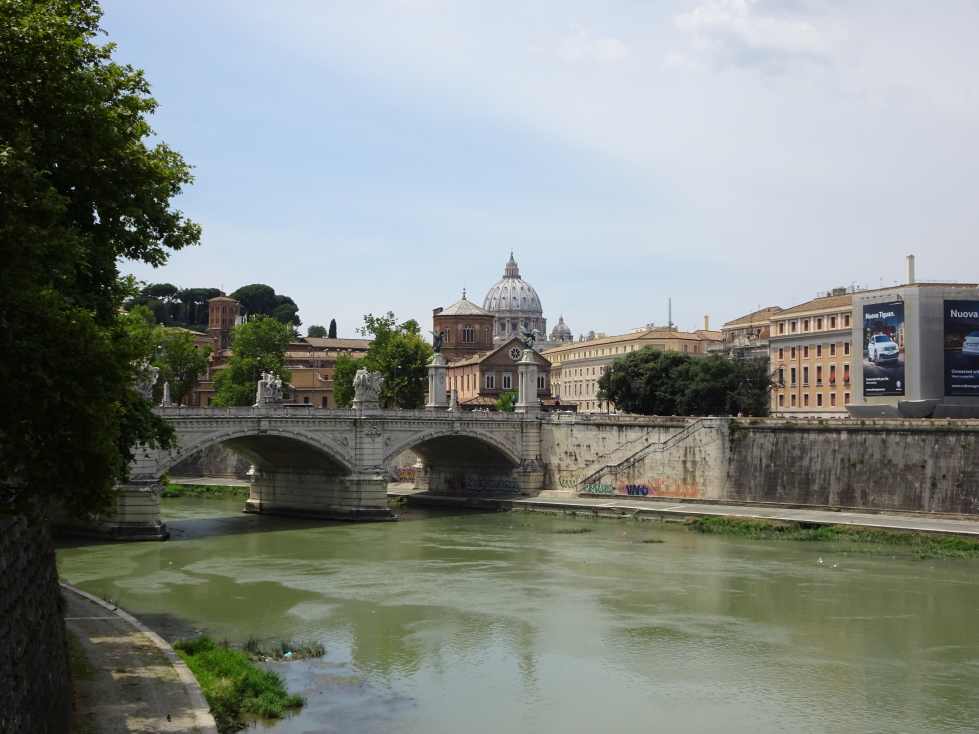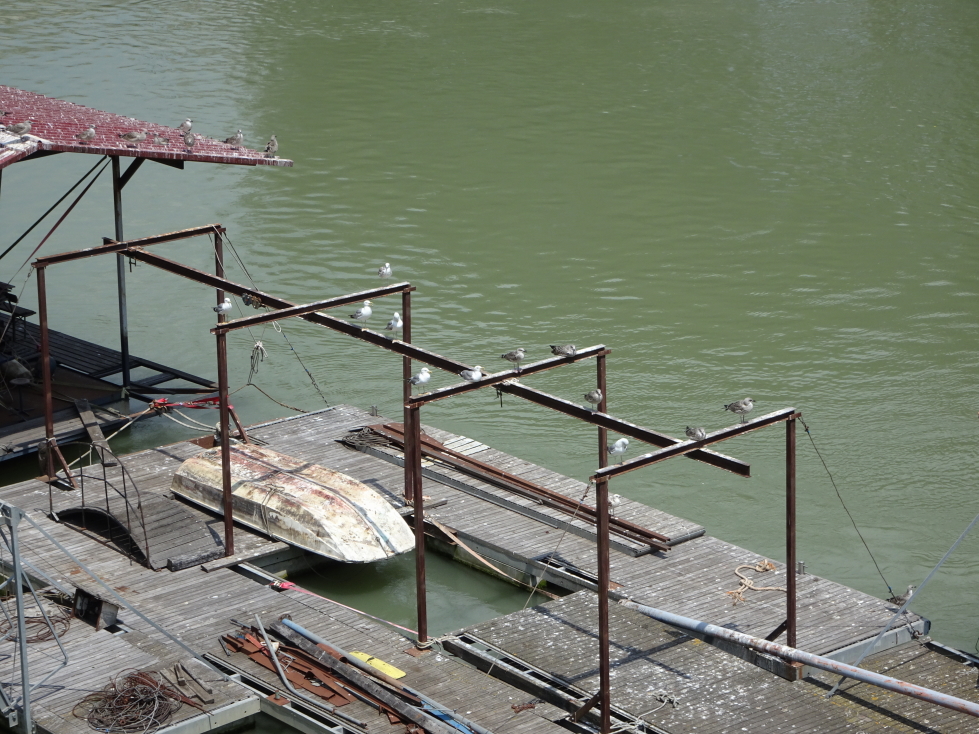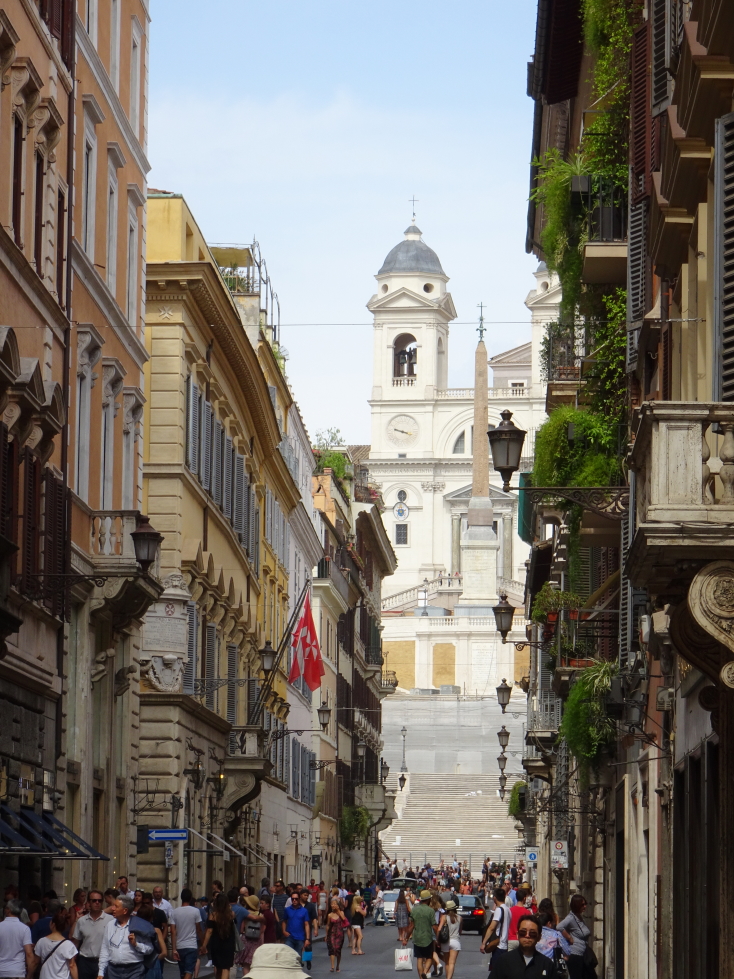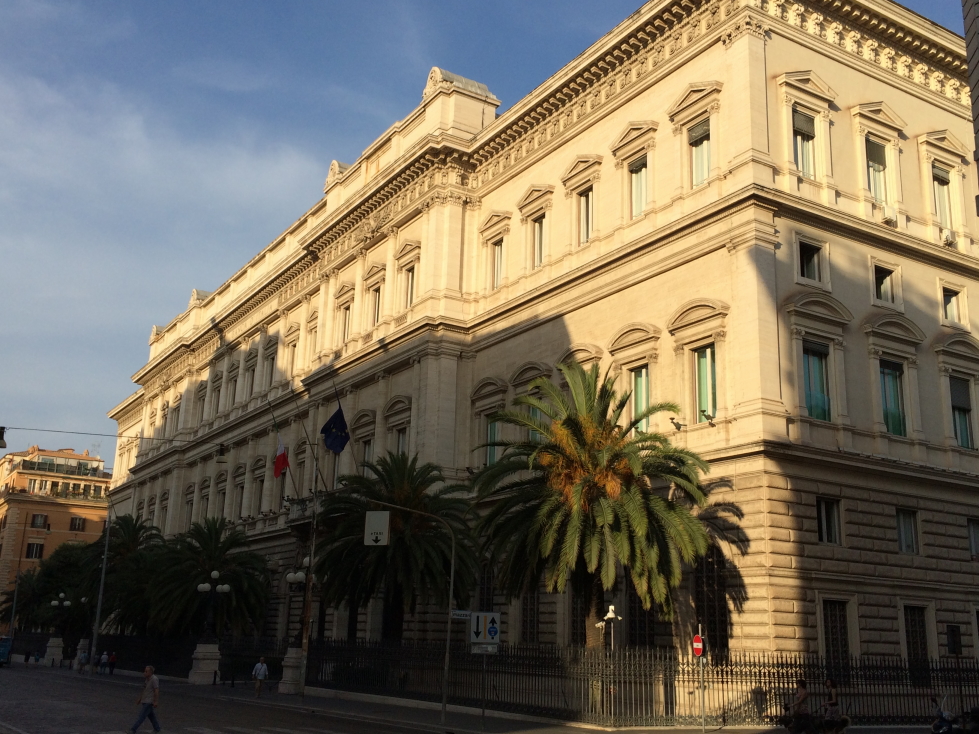We woke up about 7a and grabbed breakfast at the hotel. After many days of Continental breakfasts it was nice to have eggs, bacon, and Vienna sausages again. For Michelle and Addison’s last full day we decided to see a few of the sights we’d skipped during our earlier stay in Rome. As it was Saint Peter’s Day some stuff was closed, thankfully nothing on the list to see.
We set out about 10a, heading first to Trevi Fountain. Though Michelle and I had seen it shortly after arriving in Rome Addison hadn’t seen it, and none of us had seen it during the day. It was not quite as crowded as at night but still quite busy. There was a couple that had just been married there. It was quite hot so we didn’t linger.

Trevi Fountain in the daytime

Detail of carved flora in Trevi Fountain

Another look at Trevi Fountain
We headed west towards the Pantheon, passing by Il Tempio di Andriano (Temple of Hadrian) first. Only eleven columns of the ancient temple, built in 145AD by his adopted son, remain and had been incorporated into a 17th century papal palace that eventually became a bank. Ah, recycling! Arrived at the Pantheon at 11:05a but it was closed until 11:45a due to a liturgy. We opted to seek out lunch quickly as it was to close for good at 12:45p due to the public holiday. Ate at a pizza restaurant, Michelle had a cheese pizza, myself a mushroom pizza, and Addison had Angus steak and roasted potatoes — that he didn’t care for much. Also dining was a British guy who was in Rome for only a few hours before flying out after being on a western Mediterranean cruise.

Some of the eleven columns of the Temple of Hadrian

Closeup of the columns

One of Rome’s wonderful public drinking fountains

The Pantheon

Egyptian obelisk (from reign of Ramses II) in front of the Pantheon
We arrived back at the Pantheon to a medium line that was thankfully fast-moving so getting in with time to enjoy before closing was no issue. The temple is amazing, built around 125AD as a temple to all gods. What is remarkable is how well preserved it is. Unlike the vast majority of Roman ruins this one was never abandoned, having been in continuous use for nearly nineteen hundred years! As it was in use and was a Christian church for most of that time it wasn’t left to neglect nor plundered for marble and other resources. Its beautiful marble floor of yellow, white, and red marble — from Egypt, Numidia, and other locales — is intact.

Detail of the entrance to the Pantheon

Interior of the Pantheon

Beautiful alcove in the Pantheon
Its amazing free standing dome (still the world’s largest unreinforced concrete dome) is a marvel at 142 feet high and wide. At its apex is the oculus, a large hole that lets in light that shines down as a brilliant shaft of light. It also lets in rain; this isn’t a problem as the marble floor has little drainage holes throughout. About the perimeter of the church were tombs of the first two kings of the united Italy, Victor Emmanuel II and Umberto) as well as the Renaissance painter Raphael.

Shaft of sunlight beaming through the oculus of the Pantheon

Small holes in the marble floor of the Pantheon allow rain water to drain

Interior of the Pantheon, an active church 1900 years later!
Leaving the Pantheon we headed northwest toward the Pont Sant’Angelo. We passed through the Piazza Navona, a large plaza built on the site of the Stadium of Domitian built in 80AD. A fountain topped by a Roman obelisk from about that time stood in front of the impressive church Sant’Agnese in Agone. On the way we saw an amazing toy metal soldier store, sadly closed due to the holiday. We also made a pit stop at a cafe for bathrooms and had cokes and a chocolate cookie. The neighborhood was quiet and artsy, a welcome respite from the crowd of tourists near Trevi and the Pantheon.

Sant’Agnese in Agone with Obelisk of Domitian in front

Small church in Roman neighborhood

Another scene in the tranquil Roman neighborhood

Window display of many amazing toy soldiers
Crossed Pont Sant’Angelo, built in the early 100s for access to Hadrian’s mausoleum at Castel Sant’Angelo. It was quite impressive as it spanned the wide Tiber and had a series of angel sculptures grace both sides. Castel Sant’Angelo was impressive, an imposing structure originally intended as Hadrian’s mausoleum but later became a papal fortress, residence, and prison. A secret passage to the Vatican helped Pope Clement VII escape the 1527 sack of Rome (though the entire Swiss guard contingent left behind did not fare so well…). We didn’t do much at the Castel, being a bit museumed out. We left shortly after Michelle was done going to the restroom and headed northeast along the right bank of the Tiber.

View of the Tiber with Saint Peter’s beyond

Pont Sant’Angelo and Castel Sant’Angelo beyond

One of the angel statues on Pont Sant’Angelo

Ponte Vittorio Emanuele II spanning the Tiber

Pont Sant’Angelo from the right bank of the Tiber

Castel Sant’Angelo
It was a very pleasant walk as it was amply shaded by trees. We saw a guy fishing with an extremely long pole (nearly twenty feet, it looked like) as well as small boats at docks along the grassy riverbank. We passed a very impressive building called the Palace of Justice where the Italian equivalent of our Supreme Court sits. There was also a long row of book and coffee stands. Crossing the Pont Cavour we emerged back on the left bank of the Tiber near our next destination.

Palace of Justice, Italy’s Supreme Court site

Vendor stands along the Tiber

Typical tiny gas station in Rome

Dock with small boats and gulls in the Tiber
The Ara Pacis, or Altar of Peace, was built by Augustus as part of his reorienting Roman life to be more cult god centered. Fragments of the altar had turned up for years but it wasn’t until the 1800s that the dots were connected and there was an effort to get the pieces from all the places it had been dispersed to — Paris, Florence, the Vatican, etc. The main part of the altar was discovered under a theater in the early 1900s. It wasn’t until the 1930s, however, that they could finally excavate by using liquid nitrogen to freeze the water seeping in from the tiber as the hole was 27 meters (nearly 100 feet!) deep.

Spanish Quarter near where the Ara Pacis museum is located

Chiesa di San Rocco adjacent to the museum
Mussolini made the altar a centerpiece of his new Roman Empire and built a pavilion for it. In the 2000s, however, a new building was built around it. Designed by an American architect, Italians are quite divided on it. It is a very modern-looking building with glass all around allowing a view of the altar within. It reminded me a lot of the Metropolitan Museum of Art’s similar structure surrounding their small Egyptian temple.

Museum housing the Ara Pacis
The altar itself was really cool. Guests could walk up in it and all around it. There was a decent intro film and some models of how the altar and surrounding area looked in Roman times. The altar, now only carved white marble, was once brightly painted. Below the main floor was the exhibition floor. On exhibition were photos by Japanese realism photographer Domon Ken. He was active during both pre- and post-World War II Japan and it was fascinating to see the change in life of that country during that period. His later work consisted of photographing beautiful shrines — absolutely jaw dropping.

The Ara Pacis, or Altar of Peace, built by Augustus

Closer view of a part of the Ara Pacis
Leaving the Ara Pacis we passed a tree-filled mound of dirt and stone that was Augustus’ Mausoleum. It wasn’t restored at all and was neat to see in a ruined state through a fence (that sported odd modern “art” pieces attached to it). We stopped at a nearby gelato shop and got shakes — Michelle had strawberry, Addison oreo, and myself coffee (of course). We walked south past the Spanish steps (empty as they were being cleaned and renovated) and down some fashion streets selling ties and the like.

Mausoleum of Augustus with a church in the background

I love the use of black paint to outline the architecture

The Spanish Steps
Got some more water from a fountain shortly before returning to Hotel Bolivar for siesta and some blogging. Awoke and headed out for dinner about 7:30p or so, getting some cash along the way. We went to the place we went to our first night in Italy, Hostaria Al Boschetto. Michelle had lasagna, myself spaghetti al carbonara, and Addison pork fillets and roasted potatoes. We had “garlic” bruschetta as an appetizer. Afterwards we tried to find some snacks for them for the trip back but they were all strange brands so we passed. Did get some gelato on the way back, however! Once back at the room we packed until midnight when we went to bed.

Banca D’Italia in Rome